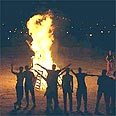
Lag B'Omer
None
Lag B'Omer is a Jewish holiday celebrated on the thirty-third day of the Counting of the Omer, which is on the 18th of the Jewish month of Iyar (usually in mid-May). The holiday's name refers to the 33rd day of the count, which in turn refers to the seven weeks separating Passover and Shavuot.
According to tradition, the counting is used as a reminder of the link between Passover, which commemorates the exodus of the Israelites from Egypt, and Shavuot, which commemorates the giving of the Torah on Mount Sinai; however Lag b'Omer is not a bible-ordinance holiday.
The holiday's main tradition is the lighting of bonfires. Many also visit Mount Meron, which is the burial place of the Jewish sage Rabbi Shimon Bar Yochai, who died on this day.

Celebrating at Mount Meron (Photo: Reuters)
The induction of Lag B'Omer also annuls the prohibition put on holding marriage ceremonies and cutting hair during the Counting of the Omer: Tradition links the holiday to a plague which ravaged through the Jewish community around 70 CE, after which a 33-day mourning period was called – hence the ban.
According to other traditions, Lag B'Omer is believed to be the day in which the Great Flood began: "In the six hundredth year of Noah's life, on the seventeenth day of the second month – on that day all the springs of the great deep burst forth, and the floodgates of the heavens were opened," (Genesis 7:11). Several ancient Jewish texts also link it to agriculture and harvests.
Modern Jewish tradition links the holiday to the Bar Kokhba revolt against the Roman Empire (132-135 AD). The Zionist Movement celebrated the revolt as a symbol for the fighting Jewish spirit. Appropriately, on Lag B'Omer 1941 the Hagana's regular fighting force – the Palmach (Strike Squadrons) – was established. Seven years later, on Lag B'Omer 1948, the official order inducting the Israeli Defense Forces was given.










